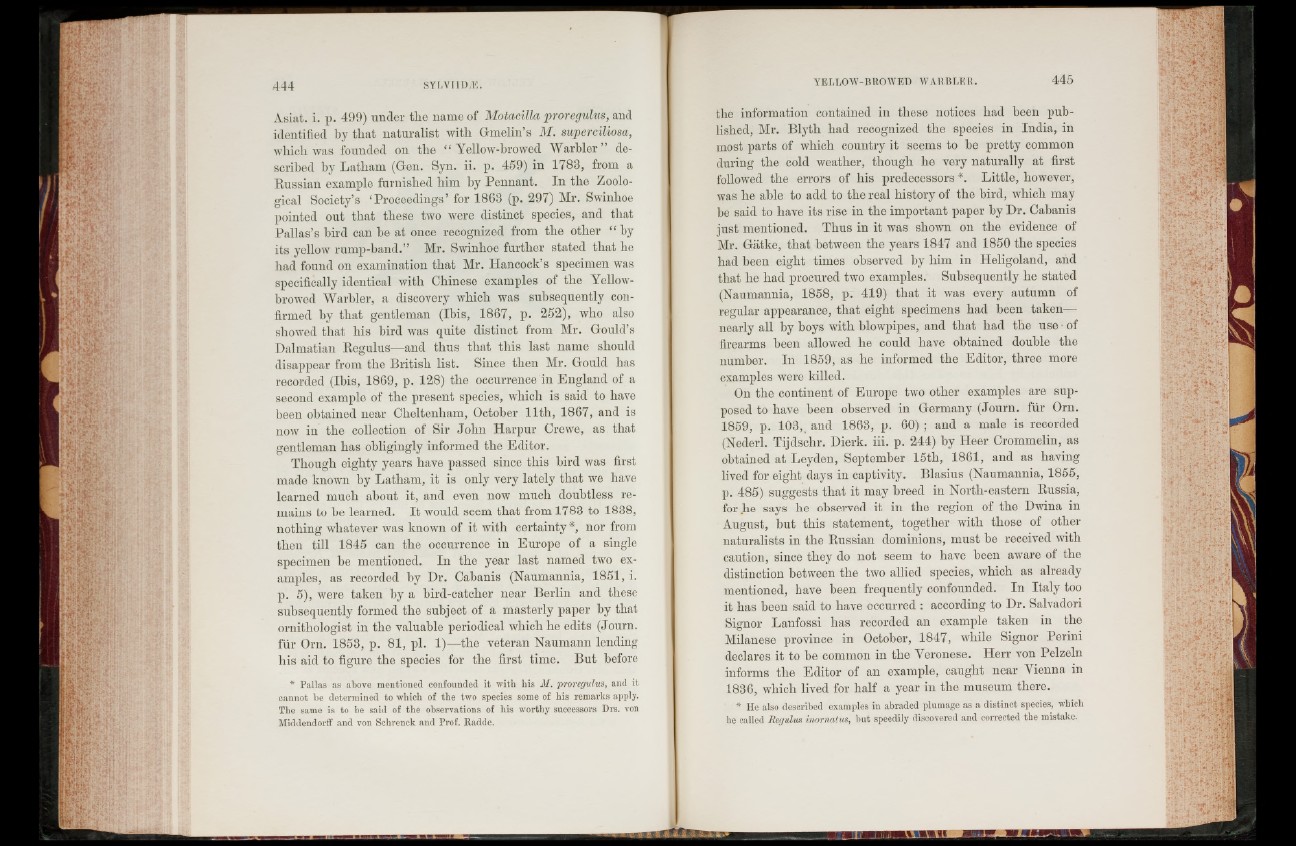
Asiat. i. p. 499) under the name of Motacilla proregulus, and
identified by that naturalist with Gmelin’s M. superciliosa,
which was founded on the “ Yellow-browed Warbler ” described
by Latham (Gen. Syn. ii. p. 459) in 1783, from a
Russian example furnished him by Pennant. In the Zoological
Society’s ‘Proceedings’ for 1868 (p. 297) Mr. Swinhoe
pointed out that these two were distinct species, and that
Pallas’s bird can be at once recognized from the other “ by
its yellow rump-band.” Mr. Swinhoe further stated that he
had found on examination that Mr. Hancock’s specimen was
specifically identical with Chinese examples of the Yellow-
browed Warbler, a discovery which was subsequently confirmed
by that gentleman (Ibis, 1867, p. 252), who also
showed that his bird was quite distinct from Mr. Gould’s
Dalmatian Regulus—and thus that this last name should
disappear from the British list. Since then Mr. Gould has
recorded (Ibis, 1869, p. 128) the occurrence in England of a
second example of the present species, which is said to have
been obtained near Cheltenham, October 11th, 1867, and is
now in the collection of Sir John Harpur Crewe, as that
gentleman has obligingly informed the Editor.
Though eighty years have passed since this bird was first
made known by Latham, it is only very lately that we have
learned much about it, and even now much doubtless remains
to be learned. I t would seem that from 1783 to 1838,
nothing whatever was known of it with certainty *, nor from
then till 1845 can the occurrence in Europe of a single
specimen be mentioned. In the year last named two examples,
as recorded by Dr. Cabanis (Naumannia, 1851, i.
p. 5), were taken by a bird-catcher near Berlin and these
subsequently formed the subject of a masterly paper by that
ornithologist in the valuable periodical which he edits (Journ.
fur Orn. 1853, p. 81, pi. 1)—the veteran Naumann lending
his aid to figure the species for the first time. But before
* Pallas as above mentioned confounded it ■with his M. proregulus, and it
cannot be determined to which of the two species some of his remarks apply.
The same is to be said of the observations of his worthy successors Drs. von
Middendorff and von Schrenck and Prof. Radde.
the information contained in these notices had been published,
Mr. Blyth had recognized the species in India, in
most parts of which country it seems to be pretty common
during the cold weather, though he very naturally at first
followed the errors of his predecessors *. Little, however,
was he able to add to the real history of the bird, which may
be said to have its rise in the important paper by Dr. Cabanis
just mentioned. Thus in it was shown on the evidence of
Mr. Gatke, that between the years 1847 and 1850 the species
had been eight times observed by him in Heligoland, and
that he had procured two examples. Subsequently he stated
(Naumannia, 1858, p. 419) that it was every autumn of
regular appearance, that eight specimens had been taken—
nearly all by boys with blowpipes, and that had the use of
firearms been allowed he could have obtained double the
number. In 1859, as he informed the Editor, three more
examples were killed.
On the continent of Europe two other examples are supposed
to have been observed in Germany (Journ. fur Orn.
1859, p. 103,. and 1863, p. 60) ; and a male is recorded
(Nederl. Tijdsclir. Dierk. iii. p. 244) by Heer Grommelin, as
obtained at Leyden, September 15tli, 1861, and as having
lived for eight days in captivity. Blasius (Naumannia, 1855,
p. 485) suggests that it may breed in North-eastern Russia,
for lie says he observed it in the region of the Dwina in
August, but this statement, together with those of other
naturalists in the Russian dominions, must be received with
caution, since they do not seem to have been aware of the
distinction between the two allied species, which as already
mentioned, have been frequently confounded. In Italy too
it has been said to have occurred : according to Dr. Salvadori
Signor Lanfossi has recorded an example taken in the
Milanese province in October, 1847, while Signor Perini
declares it to be common in the Veronese. Herr von Pelzeln
informs the Editor of an example, caught near Vienna in
1836, which lived for half a year in the museum there.
* He also described examples in abraded plumage as a distinct species, which
he called Regulus inornatus, but speedily discovered and corrected the mistake.
V.U.